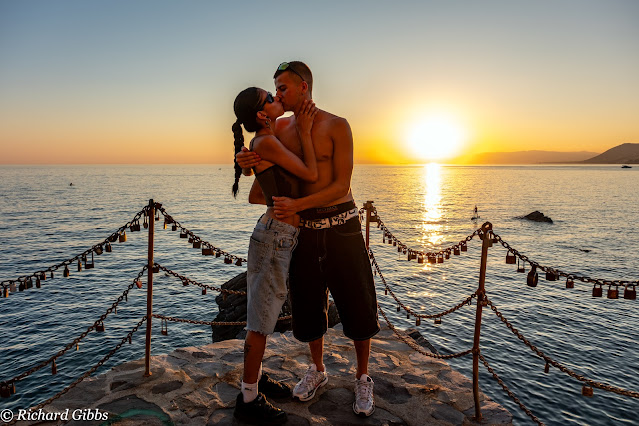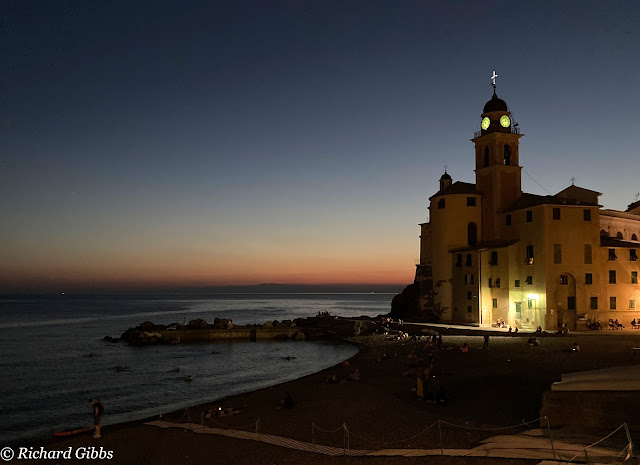Ecce Homo - You win some....

The last time I passed through Genova I was marshalling a group of students who had managed to evade the sniffer dogs in the customs bays. We were on our way back to Rome from a crazy trip to Barcelona, when the Sagrada Familia was still a building site, and the sun going down over the Pyrenees couldn't be photographed without flash.....
Anyway, I'm back, and this is my staircase (don't ask, it's too hot.....)
Oh Lordy, things have changed..... The last time I stayed here the only tourist was me, and that was a mistake. I came to look for traces of Byron and Dickens (I had a thing about literary freaks). I found them, I think, but I have lost them again..... It was a good trip, however. I was young, and the city was crumbling - a juxtaposition that has now begun to reverse, but, hey! Green mould was the flavour of the day and the palazzi on the Via Garibaldi (the Strada Nuova) were sinking into their own drains. What's wasn't to like?

Now there are Palaces a plenty to explore, by yourself, or, as the majority will have it, with an oh-so-knowledgeable guide who will suck all the art out of every statue or painting counting the minutes before the next bus-load.
In Via Garibaldi, the Musei di Strada Nuova connects three important Genoese palaces: Palazzo Doria Tursi (Palazzo Grimaldi Niccolò) which is the seat of the Town Hall; Palazzo Bianco (Palazzo Grimaldi Luca) and Palazzo Rosso (Palazzo Brignole Sale Rodolfo and Francesco), which is decorated with frescoes by the greatest painters of Ligurian Seventeenth century and enriched with precious furnishings.

There's understanding to be had, of course, but it's exhausting. Once Genova was a great city, importing spices and teas and coffees and chocolates and the smartest set became very very rich, sipping exotic beverages while their servants fought off the rats.....
One thing does stand out in this feast of renovation..... I always knew there was a connection between Jimi Hendrix and Paganini (my theory of karma and rebirth and all that....) and, what do you know, but the outstanding exhibit in this parade of wealth and bad taste is Paganini's guitar? {Niccolò Paganini was born in Genoa (then capital of the Republic of Genoa) on 27 October 1782, the third of the six children of Antonio and Teresa (née Bocciardo) Paganini}.
If only they could have played together......

Anyway, that's by the way. Genoa (nowadays Genova) is a city with determined links to that outpost of Europeanism, once known as Great Britain. The flag of St George was initially borrowed from Genoa by the English. Earlier on Genoa, once a powerful maritime city, adopted the St George’s Cross as its flag and St George as its patron saint during the Crusades (getting on for a thousand years ago). Then the symbol was adopted by England toward the end of the religious wars, in the 13th century, with English ships flying the flag of Genoa as a deterrent to enemies and for that privilege, the English monarch paid an annual tribute to the doge of Genoa, or ruler of the Republic of Genoa.....
And then, to turn the tables, perhaps, the English founded the Genoa Cricket and Football Club, commonly referred to as Genoa. The club was founded on 7 September 1893 as Genoa Cricket & Athletic Club. In its earliest years, it principally competed in athletics and cricket. Association football was only a secondary concern. The club was set up to represent England abroad, and at first Italians were not permitted to join.
You wouldn't know this on September 7th, 2023, when a vast crowd assembles in Piazza de Ferrari, with fireworks, flags and fierce fanaticism......
I am the only Brit in the throng and I feel discomfited by the demonstrations of mass enjoyment that have elements of something I would rather not recall....
On 10 April 1897 the footballing section of the club became predominant thanks to James Richardson Spensley. Italians were allowed to join and found a new ground in the form of Ponte Carrega.
James Richardson Spensley (17 May 1867 – 10 November 1915) was an English medical doctor, footballer, manager, Scout Leader and medic from Stoke Newington. He is considered to be one of the "Fathers of Italian Football", due to his association with Genoa CFC and his contribution to the modern day variation of the game in Italy.
There aren't many occasions these days when I feel anything like a spark of pride to be British, but I have to seize the day....
It is quite something to be in a huge crowd and not to be worried, but here the people are genuinely focussed on their sense of community and you cannot help but feel good that they have something to believe in....
The city is older than all of us put together, and GCFC, at exactly 130 years old, is old enough to be all of our great grandfathers, if not greater. But there is an inclusive zing to the celebrations.
Of course there is much more to the city (at the least that is an opinion) and I take time to ascend the funiculars and the lifts to see the views, including that of the Lanterna di Genova, the main lighthouse for the port. Besides being an important aid to night navigation in the vicinity, the tower serves as a symbol and a landmark for the City of Genoa. Built of masonry, at 76 m (249 ft) it is the world's fifth tallest lighthouse and the second tallest "traditional" one.
And I note the antique beasts that guard the Metropolitan Cathedral of Saint Lawrence. It is dedicated to San Lorenzo and was consecrated by Pope Gelasius II in 1118 and was built between the twelfth century and the fourteenth century
Up the 130 (or so) steps to the tower a relaxed guide instructs visitors in his lessons about life and all that......
Back in the port the people are continuing celebrations of the 130th anniversary of their beloved football club, introducing the youth and hopes for the future that form part of the business of the enterprise.... Genoa for Special!
And special Genoa is.... through there are times when things don't go quite right and the other team may win.... OK. Good luck to them. Antonello da Messina (Messina, 1426 circa - 1479) understood this and in his picture, Ecce Homo (Behold the Man), one version of which is on display in the Spinola picture gallery in Palazzo di Pellicceria. The scourged and mocked Christ is shown wearing a crown of thorns placed on him by the Roman soldiers. In some versions of this his wrists are tied and a rope is knotted around his neck; scourge marks are frequently emphasised, and his face expresses compassion toward his accusers.
It is the picture of a man. A man in agony. Someone whose team has lost. But, given faith, someone whose team may one day win the cup....
One day.
We must live in hope.....
Genoa for Special.....




















































